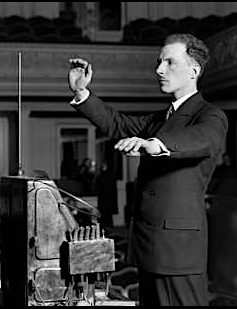
Theremin demonstrating his instrument, 1927.
By a remarkable coincidence (cf. Köchel), the theremin was invented by Léon Theremin (Lev Sergeyevich Termen, 1896–1993). Given that its timbre is surely that to which singers and instrumentalists aspire, it seems sad that its profile remains largely limited to the niches of film music and “lollipops”.
Termen was drawn to experiments in physics and electrons from his teens. After World War 1 and the civil war Abram Fedorovich Ioffe recruited him to the Physical Technical Institute in Petrograd. In 1920 he invented the instrument that would become known in the USA as theremin. As a cellist, one of the early pieces he adapted was The swan (see below). In this 1954 clip he demonstrates the instrument:
Having married Katia Konstantinova in 1924, he spent time on tour in Europe before they moved to the USA in 1927. His concerts on the theremin soon became popular, and he set up a laboratory in New York, devising a range of inventions, including new electronic musical instruments. As he became the toast of New York society, he was conducting industrial espionage for the Soviet state.

With Clara Rockmore.
Apparently irrespective of the Soviet Consulate’s demands that he should divorce his wife, Theremin proposed to emigré Lithuanian violinist Clara Rockmore (née Reisenberg, 1911–98), who became renowned as a theremin virtuoso. Instead, when Clara married an attorney, Theremin married the African-American dancer Lavinia Williams in the mid-1930s, to some controversy; with racial tensions such a thorny issue, this might have made an interesting match. But in 1938, concerned over his financial problems and the imminent global conflict—and perhaps under pressure from his Soviet minders anxious that his spying activities might be exposed—Theremin returned abruptly to the USSR, whereafter Lavinia never saw him again.
With Stalin’s great purge under way, he was promptly imprisoned. He was sent to work at a sharashka research facility in the remote Kolyma gulag, devising eavesdropping devices. After his release in 1947 he remarried. Rehabilitated in 1956 following the death of Stalin, he continued serving the KGB until 1966, also working at the Moscow Conservatoire.
In 1962 Clara took her husband for a holiday visit to her homeland, and on their visit to Moscow they managed to arrange a clandestine meeting with Theremin at his flat in Moscow. But outside Russia no-one knew if he was still alive until 1967, when Harold Schonberg published an article in the NYT about visiting him at the Conservatoire. This exposure brought his work to the attention of the Director, who declared that “electricity is not good for music; electricity is to be used for electrocution“; his instruments were thrown out, and he was dismissed.
When Lavinia visited Clara in 1974, she was glad to learn that Theremin was still alive; as she started corresponding with him, he even proposed remarriage. He was able to travel abroad only from 1989, visiting the USA in 1991—where he met Clara again.
* * *
For more, Albert Glinsky, Theremin: ether music and espionage (2005) is a fascinating study, meticulously researched. And for an imaginative fictional treatment, this tangled web makes a fine theme for the novel by Sean Michaels, Us conductors (2014). Focusing on Theremin’s relationship with Clara, the story takes in the Russian Revolution, America’s Great Depression and the celebrities of the day, Stalin’s gulag, two world wars, the cold war, and perestroika. Indeed, following the 1993 documentary Theremin: an electronic Odyssey (trailer here), the subject seems to cry out (eerily) for a movie version…
For the American episode, Michaels musters an all-star cast, including Rachmaninoff, Toscanini, Joseph Schillinger, the Marx brothers, Glenn Miller, Nicolas Slonimsky, and George Gershwin. He captures the magic of Clara’s presence:
You crouched in black on the terpsitone’s platform, as if you were praying, centred in a spotlight. Carlos, the harpist, sat beside you. In the wings, I held my breath.
You stood, slowly, staring into the room’s rapt silence. You arched your back. You were a black-barked cherry tree. You were my one true love.
With Carlos you played Bach and Gounod’s “Ave Maria”. Each note was shown in a beam of light. I had built a loudspeaker, covered it in twill, raised on a simple mount above the stage. Your music pushed like breath against the cloth. It trembled and then sang. You danced, choosing every moment, guiding the melody with a rolled shoulder and the tilt of knee. At the clubs you had not danced like this.
* * *
Theremin was interested in a role for the instrument in dance music, developing performance locations that could automatically react to dancers’ movements with varied patterns of sound and light. And the instrument was to be a gift for film soundtracks.

Among several YouTube playlists, this one features 64 tracks by the great Clara Rockmore—opening magically with The swan:
Even by the other-worldly standards of the theremin, her rendition of Vocalise is Something Else:
And here’s Theremin’s last pupil, his grand-niece Lydia Kavina playing Clair de lune:
A current star of the theremin is Carolina Eyck. Her YouTube channel includes Moon river:
For Bach, see also under The Feuchtwang Variations (Grégoire Blanc, website and YouTube channel), and Strings and voices (Gladys Hulot (aka hYrtis), website and YouTube channel; here she also plays Only you). Suitably, both players double on the musical saw—here Blanc plays them together:
Messiaen was much taken by the ondes martenot, but some of his works adapt well to the theremin too:
And the cello movement of the Quatuor pour la fin du temps works wonderfully with the winning combo of theremin and accordion:
Now I’m imagining the theremin in dhrupad or Tibetan opera…


